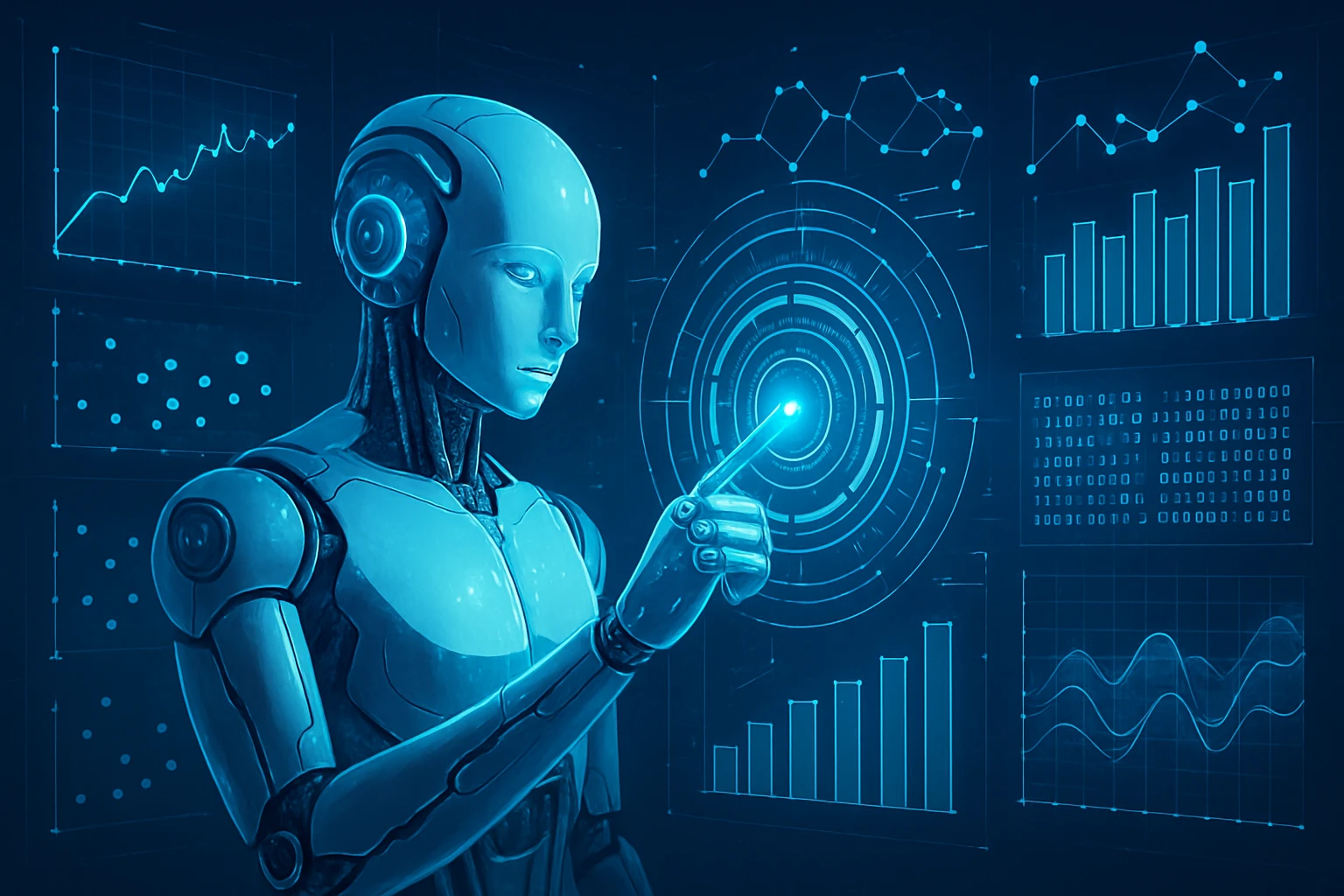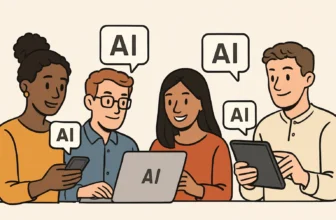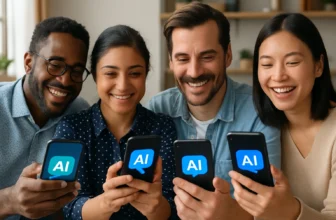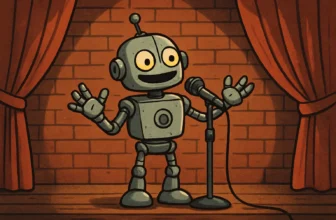
Is Multimodal AI the Next Big Thing?
80% of the data we experience daily isn’t just text — it’s a swirl of images, sounds, conversations, and sensations. Wild, right? We’re constantly processing so much, and now, AI is catching up to how we actually perceive the world.
This is where multimodal AI comes in — and yes, it’s kind of a big deal. Think of it like giving AI superpowers: instead of just reading words like traditional models, it’s now seeing, listening, and even feeling (in a digital sense, of course). We’ve moved from giving AI a dictionary to handing it an entire sensory toolkit.
So, what’s the problem traditional AI had?
Let’s be real — plain old text-based AI can feel… kinda flat. I remember building an NLP bot a couple of years back for a product demo. Solid code. Beautiful syntax. Except it couldn’t tell the difference between a sarcastic tweet and a genuine compliment. It read “Yeah, that’s just great 🙄” and replied with a cheerful “Happy you’re enjoying it!” 😬 Yikes.
The core issue? Traditional AI models were like people who only read books but never watched a movie or listened to music. They could process data—but lacked the context and depth that comes from understanding multiple modalities (like sight, sound, and even touch in advanced apps).
Here’s how multimodal AI is flipping the game:
- Smarter outputs: When AI can combine text with visuals (think GPT-4 with image input), it gives more accurate, relevant, and human-like responses.
- Contextual understanding: Voice tone + facial expressions + words? That combo helps AI get what you actually mean. This unlocks more intuitive customer support, personalized learning, even emotion-aware wellness apps.
- Creative breakthroughs: Artists and developers are already creating with tools that generate music, images, and scripts simultaneously — real multimodal magic.
I always tell my fellow devs—if you haven’t played with something like CLIP or Florence yet, do it. Just feeding it an image and having it describe what’s happening (not just objects, but the vibe)? It’s the future sneaking in quietly.
Where do we go from here?
Multimodal AI isn’t just a buzzword — it’s the cornerstone of the future of AI. From self-driving cars that combine camera feeds and road signs to medical systems that interpret images + patient histories, this tech is paving the way for more holistic (and frankly, more human) AI systems.
So what can you do?
- Explore the tools: Try out open-source platforms like Hugging Face’s multimodal models or deep dive into OpenAI’s latest developments.
- Experiment and build: Combine image and text inputs in your projects. You’ll be shocked at the difference it makes.
- Stay curious: The tech moves fast — subscribe to updates, join AI communities, and keep learning.
Bottom line? We’re entering a golden age where AI feels less like a calculator and more like a collaborator. So whether you’re a curious coder or just a tech dreamer, buckle up. Multimodal AI is just getting started, and it’s going to be thrilling.
Why Multimodal AI Matters More Than Ever
Did you know that humans process over 90% of information through more than one sense at a time? Think about it — when you’re at a café, you’re not just hearing someone talk; you’re also reading their facial expressions, noticing their hand gestures, catching the scent of roasted coffee, and maybe even feeling your phone buzz in your pocket. We take in the world from every angle — eyes, ears, touch — all working *together* to form a complete picture.
But traditional AI? Yeah, not so much. Most older AI systems are single-modal, meaning they can only handle one type of input. So maybe they can interpret your text. Or your voice. Or an image. But not all at once and certainly not in sync. That’s like trying to understand a movie by only listening to the dialogue with a blindfold on. You’d miss all the nuance — the smirks, the background action, the foreshadowing in the lighting.
That’s exactly where multimodal AI steps in, pumped and ready to level up the game.
The Problem: Our Lives Are Too Complex for Single-Modal AI
Let me give you an example. Have you ever asked Siri something simple — like “What’s the weather like?” — and it nails it? But the moment you say, “Do I need an umbrella later, based on these dark clouds?” it’s… confused. Why? Because it processes just your voice. It has no idea you’re looking at storm clouds or gesturing toward the window.
I had this exact moment the other day. I asked a smart assistant to help me choose a recipe based on the fresh produce I was holding up to the camera. Crickets. It couldn’t blend visual context with voice. That’s when it hit me: single-modal AI still sees us piecemeal. And we’re anything but one-dimensional.
The Solution: Enter Multimodal AI
Multimodal AI integrates text, audio, visuals, sensor data — even bio-signals — into a single, cohesive model. Think of it like a mega-smart octopus with a brain that processes everything happening through all its arms at once. This means smarter virtual assistants, better autonomous vehicles, even AI in healthcare that can interpret X-rays, patient records, and verbal symptoms — all together.
- Case Study #1: Google Assistant’s latest versions now fuse voice requests with screen context. Say you’re texting about dinner and you say, “Book us a table here,” the assistant understands “here” as the restaurant in your messages. That’s classic multimodal action.
- Case Study #2: Siri’s evolution (though slower) is also playing catch-up. Enhanced versions now pull in app context, touch signals, even ambient noise to improve responses.
- Developer Tip: Building AI solutions? Explore platforms like OpenAI’s GPT-4 or DeepMind’s Flamingo models. They’re designed to harmonize multiple input types right out of the gate.
Looking Ahead: A Smarter, More Human AI
Multimodal AI isn’t just a tech trend — it’s a must for where we’re headed. Whether it’s more immersive VR worlds, adaptive robot helpers, or genuinely intuitive assistants, the future of AI needs to understand us the way other humans do: in full color, stereo sound, and real-time vibe checks.
So yes, the journey’s just getting started. But as developers and tech lovers, we’re in the driver’s seat. Let’s build AI that gets the whole picture — not just a pixel of it.
From Concept to Reality: Transformative AI Applications
Did you know? Multimodal AI is already helping detect diseases like cancer with up to 20% improved accuracy simply by combining text-based patient records with medical imaging and lab results. Wild, right?
And here’s the kicker — you’ve probably interacted with multimodal AI without even realizing it. Ever asked your smartwatch an oral question and watched it analyze your voice and vital signs to give you health tips? Boom. That’s multimodal AI doing its thing. It’s not just science fiction anymore — it’s quietly woven into your everyday scroll, click, and beep.
The Magic Behind the Curtain
So, let’s break it down. Multimodal AI is all about combining different data sources — imagine text, voice, images, video, and even physical sensors — to make way smarter decisions. Individually, each of these data types gives part of the story. But together? They’re like the Avengers of information processing. Way more powerful as a team.
I’ve seen this firsthand when helping a startup that used multimodal AI for agricultural monitoring. They combined satellite images (visual), temperature/humidity (sensor), and farmer notes (text) to predict crop disease three days in advance. That’s a game-changer for food security, right?
Where It’s Already Making a Difference
- Healthcare: AI systems now analyze MRI scans alongside doctor’s notes to detect early signs of neurological disorders. Pairing visuals with historical medical text gives more context for faster, more accurate results.
- Smart Vehicles: Your car hears a siren (audio), sees flashing lights (visual), and automatically pulls over. Systems blend cameras, mic arrays, and LiDAR to make real-time safety decisions. Less stress, more peace of mind.
- Customer Service: Ever chatted with a bot that “gets” you? Multimodal AI combines your typed text, voice emotion, and even previous behavior to serve better, human-like responses. It’s helping businesses scale support without losing the personal touch.
How Can You Ride This Tech Wave?
If you’re a tech dev or curious innovator, here’s how you might bring multimodal AI into your world:
- Start with the problem, not the tech. What data types are involved in solving your use case? Pair unusual combinations — text + sound, image + sensor data — to see hidden patterns.
- Leverage existing libraries. Open-source tools like Hugging Face’s Transformers or Google’s MediaPipe make it easier to experiment, even solo.
- Prototype fast. Use Figma or Streamlit to quickly visualize output combinations. Nothing builds buy-in like proof of concept with real data.
Peeking Into Tomorrow
The beauty of this tech? It doesn’t just automate — it augments human potential. From helping visually impaired folks navigate streets using camera+audio combo, to translating sign language in real-time, the path forward is full of jaw-dropping possibilities.
So yes, multimodal AI is already transforming the world. But we’re still early in the story. And here’s the exciting part — you don’t have to just watch it unfold. You can be one of the builders.
Ready to mix, match, and invent the next life-changing use case? Let’s go!
Challenges Facing Multimodal AI Adoption
Did you know that training a single multimodal AI model can require as much energy as 100 homes use in a year? Wild, right? And that’s just one of the many hurdles the AI community is staring down when it comes to bringing multimodal AI into the mainstream.
Multimodal AI is exciting — it’s like the rockstar of the AI world, blending vision, language, audio, even touch data into one brainy system. We’re talking voice assistants that understand tone, robots that recognize both faces and commands, or medical AIs that combine MRIs and reports to diagnose illnesses. Amazing stuff. But here’s the catch: getting it to actually work at scale? Not so easy.
Why It’s Tougher Than It Looks
Let’s get real here. If you’ve ever tried syncing data from multiple sources — like your photos from your phone, cloud, and external drive — you already know it can be a migraine. Now multiply that by a few million data points in completely different formats: images, text, audio clips, and more. You’re basically trying to get them to speak the same language without checking into therapy.
And even when you’ve got high-quality data, the computational load is massive. Imagine trying to teach a toddler to speak, identify colors, and tap dance all at once — oh, and do it in real time. That’s what we’re asking of our models. It’s no wonder adoption feels slow in the wild.
How Experts Are Battling Back
But here’s the good news — the AI community is anything but passive. Let me share what’s really working:
- Cross-field collaboration: Researchers and developers from machine learning, natural language processing, computer vision, and neuroscience are finally sitting at the same table. We’re seeing interdisciplinary teams lead to smarter integration pipelines, making multimodal alignment more natural and scalable.
- Smarter model design: Transformer architectures like CLIP and Flamingo are changing the game. They’re designed specifically to “understand” multiple modalities without needing a separate processor for each type of input. Think of them like the universal remotes of AI.
- More efficient computation: Thanks to tricks like sparse attention, knowledge distillation, and edge-optimized AI, teams are now trimming down the power demands. One company I consulted for recently reduced their training time by 40% using optimized data batching and shared embeddings across modalities. It saved them tens of thousands in compute costs!
The Road Ahead Looks Bright
Sure, multimodal AI is hard — but what new tech was ever easy at first? Remember when voice assistants could barely hear you unless you screamed like a banshee? Now they can reorder your groceries with a whisper (well, mostly).
The bottom line is: the challenges are real, but so is the momentum. As talent pools grow, tools evolve, and innovation speeds up, multimodal AI is shifting from “cool idea” to “industry standard.” So if you’re a dev, a researcher — or just a curious tech fan — now’s an amazing time to lean into the future. The breakthroughs are coming faster than we think.
So keep learning, keep building, and don’t be afraid to dive in. The future’s saying, “Come join the party.”
Pioneering the Future: Trends and Predictions
Did you know that multimodal AI is now not only reading and writing like us—but starting to *create* like us too? Yep. A recent study found that AI-generated images outperformed human-created ones in blind taste-tests on creativity. Say what?! 🤯
This isn’t just cool tech trivia. It’s a signal. Multimodal AI, which blends text, image, audio—even video—into a single system? It’s not just getting smarter. It’s redefining how we interact with the world.
The Big Shift: From Assistants to Collaborators
For the longest time, AI felt like that ultra-efficient assistant: great at fetching info, running scripts, analyzing data. But what’s changing now—what’s *really blowing minds*—is that AI isn’t just doing chores anymore. It’s becoming a creative peer.
I remember when I first experimented with a multimodal model that could take a sketchy napkin drawing, understand the context via a prompt, and produce a detailed product prototype. I was FLOORED. I felt like a designer, product manager, and artist all rolled into one—backed by my new AI sidekick.
So, What’s Coming in the Next Decade?
Here’s a sneak peek into the futuristic—but surprisingly near-term—trends that are emerging fast:
- AI as a Creative Partner: We’re not just talking Photoshop filters. We’re talking AI that co-writes screenplays, designs architectural layouts, and composes symphonies—with you in the driver’s seat.
- Cross-Disciplinary Fusion: Imagine a biomedical researcher feeding lab data, patient histories, and imaging scans into an AI—and getting personalized treatment recommendations that also factor in genetics, nutrition, *and* lifestyle. Wild, right?
- Emotionally Intelligent AI: Future models will read subtle tones in voice, micro-expressions in video, and context in conversations to respond more humanly. It’ll feel less like talking to a robot, more like talking to a trusted colleague (or therapist 😅).
What Can You Do Now?
These trends might sound super distant—but they’re happening fast. If you’re a developer, researcher, or just nerding out on AI like me, here are a few things you can do to get ahead of the curve:
- Start playing with multimodal APIs: Tools like OpenAI’s GPT-4, Google’s Gemini, and Anthropic’s Claude are opening doors like never before. Test, prototype, and get your hands dirty.
- Collaborate outside your comfort zone: Work with artists, psychologists, even poets. The more disciplines you’re exposed to, the more powerful your AI applications will be.
- Keep your ethical compass sharp: More powerful AI = more responsibility. Stay updated on ethical frameworks, bias mitigation, and data privacy practices.
Looking Ahead With Wide Eyes
Here’s the thing—multimodal AI isn’t just an evolution of tech. It’s kind of like discovering a new medium of thought. It’s helping us imagine in broader strokes and create in cross-sensory ways. We’re not just building smarter machines. We’re reshaping what’s possible for human-AI collaboration.
And honestly? That feels less like sci-fi and more like the start of something beautifully human.
Embrace the Multimodal AI Revolution!
Did you know that multimodal AI systems can outperform humans in interpreting certain types of data combinations? Yep, that’s right—machines are now connecting images, sound, and text in ways that mimic how *our brains* process the world. Wild, huh?
But let’s be real for a second—this isn’t just about fancy algorithms playing tag with academics. This is about *you* and *me* tapping into something that’s going to change the way we live, work, and connect. Whether you’re a hardcore developer deep in TensorFlow or just someone who nerds out over tech trends, multimodal AI is a game changer we can’t afford to ignore.
I remember the first time I saw an AI model generate a caption for an image *and* answer questions about it like a casual conversation. I literally said out loud, “Okay… this is spooky cool.” It felt like chatting with a super-smart teammate who had eyes, ears, and a language center all working together in sync. And that’s exactly the problem multimodal AI is solving—making machines less like static tools and more like interactive collaborators.
So, how can *you* ride this wave?
- Start building your skill stack: If you’re a developer, begin experimenting with multimodal transformer models like CLIP or Flamingo. Sites like Hugging Face have pre-trained models you can play with—for free!
- Get curious about cross-discipline knowledge: Not just machine learning, but fields like cognitive science, linguistics, and even art. Why? Because multimodal AI is all about combining modes of human communication. The more diverse your inputs, the better your outputs.
- Stay plugged into communities: Reddit forums, Discord groups, and GitHub threads are goldmines. Share your projects, even if they’re rough. The multimodal AI space is still new-ish, which means there’s plenty of room to be a pioneer.
Remember, the future isn’t just being *built* by multimodal AI—it’s being co-created by people like you who are willing to lean in, get their hands dirty, and dream a little bigger.
I mean, imagine the possibilities: AI that can interpret medical scans *and* explain the results in plain English. AI-powered classrooms where learners, no matter their learning style, are met with content they actually understand. Or heck, AI companions that don’t just answer questions but truly “get” you.
So, are you ready? Ready to explore, experiment, and maybe even revolutionize how people connect with technology? Because the multimodal AI revolution isn’t knocking at the door anymore—it’s already busting it wide open.
Stay curious. Stay scrappy. And hey, don’t be afraid to build something a little weird—it might just be the next big breakthrough.












